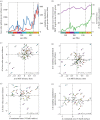The apparent exponential radiation of Phanerozoic land vertebrates is an artefact of spatial sampling biases
- PMID: 32259471
- PMCID: PMC7209054
- DOI: 10.1098/rspb.2020.0372
The apparent exponential radiation of Phanerozoic land vertebrates is an artefact of spatial sampling biases
Abstract
There is no consensus about how terrestrial biodiversity was assembled through deep time, and in particular whether it has risen exponentially over the Phanerozoic. Using a database of 60 859 fossil occurrences, we show that the spatial extent of the worldwide terrestrial tetrapod fossil record itself expands exponentially through the Phanerozoic. Changes in spatial sampling explain up to 67% of the change in known fossil species counts, and these changes are decoupled from variation in habitable land area that existed through time. Spatial sampling therefore represents a real and profound sampling bias that cannot be explained as redundancy. To address this bias, we estimate terrestrial tetrapod diversity for palaeogeographical regions of approximately equal size. We find that regional-scale diversity was constrained over timespans of tens to hundreds of millions of years, and similar patterns are recovered for major subgroups, such as dinosaurs, mammals and squamates. Although the Cretaceous/Palaeogene mass extinction catalysed an abrupt two- to three-fold increase in regional diversity 66 million years ago, no further increases occurred, and recent levels of regional diversity do not exceed those of the Palaeogene. These results parallel those recovered in analyses of local community-level richness. Taken together, our findings strongly contradict past studies that suggested unbounded diversity increases at local and regional scales over the last 100 million years.
Keywords: Phanerozoic; Tetrapoda; biodiversity; diversification; palaeontology; terrestrial.
Conflict of interest statement
We declare we have no competing interests.
Figures





References
Publication types
MeSH terms
Associated data
LinkOut - more resources
Full Text Sources
Miscellaneous

